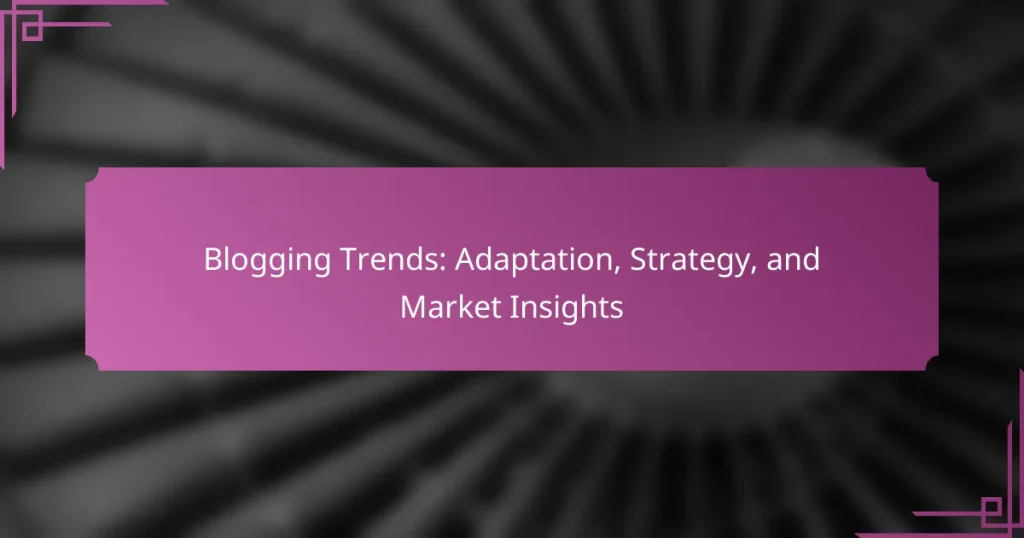In 2023, the landscape of blogging is evolving, driven by trends such as multimedia integration, SEO optimization, and community engagement. To thrive, bloggers must adapt their strategies by embracing these changes and utilizing tools that enhance content reach and interaction. Understanding effective monetization methods further empowers bloggers to connect with their audiences while generating revenue.
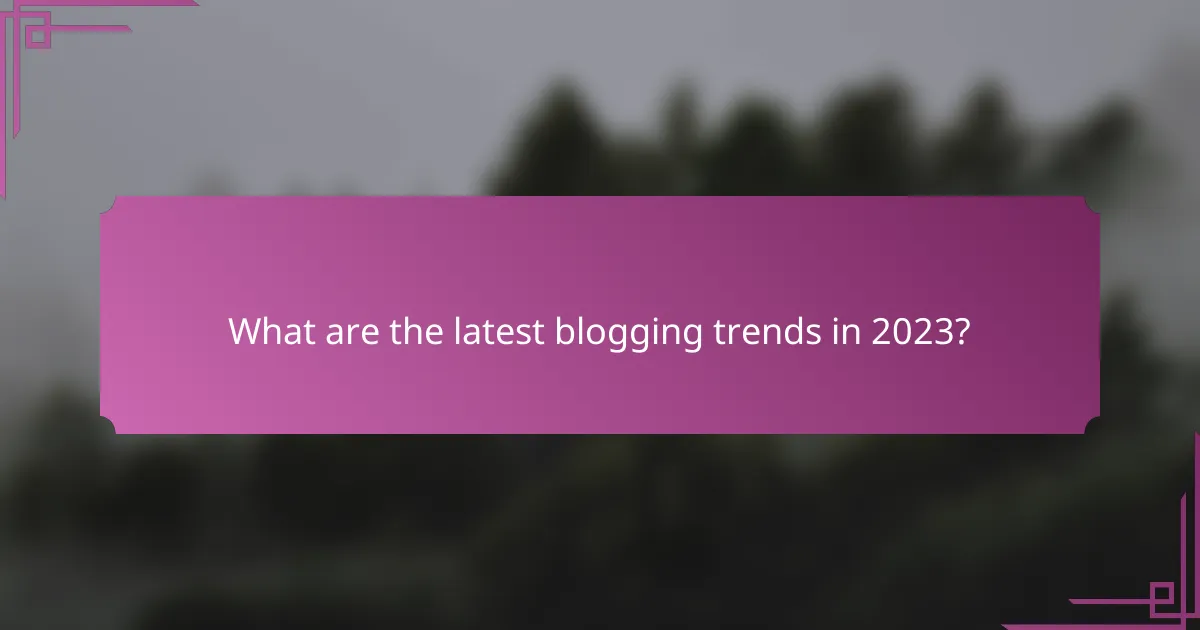
What are the latest blogging trends in 2023?
In 2023, blogging trends are increasingly shaped by multimedia integration, SEO strategies, community engagement, user contributions, and sustainability. These trends reflect a shift towards more interactive and responsible content creation that resonates with diverse audiences.
Rise of video content integration
Video content is becoming essential in blogging, as it enhances engagement and retention. Blogs that incorporate videos often see higher interaction rates, with many readers preferring visual content over text. Consider using platforms like YouTube or embedding short clips to complement written posts.
To effectively integrate video, aim for concise clips that summarize key points or provide tutorials. A good practice is to keep videos under five minutes to maintain viewer interest. Additionally, ensure that videos are optimized for mobile viewing, as a significant portion of users access content via smartphones.
Increased focus on SEO optimization
SEO optimization remains a critical trend for bloggers aiming to improve visibility and attract organic traffic. In 2023, focusing on keyword research, on-page SEO, and quality backlinks is essential for ranking higher in search engine results. Tools like Google Analytics and SEMrush can help identify effective keywords and track performance.
Bloggers should prioritize creating high-quality, relevant content that answers user queries. Regularly updating existing posts with fresh information and optimizing for featured snippets can also enhance SEO performance. Avoid keyword stuffing; instead, aim for natural integration of keywords within engaging content.
Growth of niche blogging communities
Niche blogging communities are flourishing, allowing bloggers to connect with specific audiences and foster deeper engagement. These communities often revolve around shared interests, such as travel, health, or technology, enabling bloggers to tailor their content effectively. Engaging with these communities can lead to collaboration opportunities and increased readership.
To tap into niche markets, consider joining forums, social media groups, or platforms like Substack that cater to specific topics. Building relationships within these communities can enhance credibility and provide valuable insights into audience preferences and trends.
Emphasis on user-generated content
User-generated content (UGC) is gaining traction as a way to enhance authenticity and trust. Blogs that feature contributions from readers, such as testimonials, reviews, or guest posts, can create a sense of community and encourage more interaction. UGC not only enriches content but also helps in building a loyal audience.
Encourage readers to share their experiences or insights related to your blog’s theme. Implementing contests or calls to action can motivate users to contribute. However, ensure that all user-generated content is moderated for quality and relevance to maintain your blog’s standards.
Shift towards sustainable blogging practices
Sustainability is becoming a key consideration for bloggers, with many seeking to minimize their environmental impact. This trend includes promoting eco-friendly products, adopting green hosting services, and reducing digital waste. Bloggers can position themselves as advocates for sustainability by sharing tips and resources with their audience.
To implement sustainable practices, consider using energy-efficient hosting providers and optimizing your website’s performance to reduce energy consumption. Additionally, encourage readers to engage in sustainable practices through your content, fostering a community that values environmental responsibility.

How can bloggers adapt their strategies?
Bloggers can adapt their strategies by staying informed about emerging trends and utilizing tools that enhance their content’s reach and engagement. This involves analyzing data, incorporating interactive features, and leveraging social media effectively.
Utilizing data analytics for content strategy
Data analytics helps bloggers understand audience preferences and behavior, allowing them to tailor content accordingly. By using tools like Google Analytics, bloggers can identify which topics resonate most, track engagement metrics, and adjust their strategies based on real-time feedback.
Key metrics to focus on include page views, bounce rates, and average session duration. Regularly reviewing these statistics can reveal patterns and inform decisions on future content topics, posting schedules, and promotional strategies.
Incorporating interactive elements
Interactive elements, such as polls, quizzes, and comment sections, can significantly enhance user engagement. These features encourage readers to participate actively, making them feel more connected to the content and the blogger.
Consider using tools like Typeform for quizzes or embedding social media feeds to create a dynamic experience. However, ensure that these elements are easy to use and do not overwhelm the main content, as simplicity often leads to higher engagement rates.
Leveraging social media for audience engagement
Social media platforms are essential for bloggers to reach wider audiences and foster community interaction. By sharing blog posts on platforms like Instagram, Twitter, and Facebook, bloggers can drive traffic back to their sites and engage with readers directly.
To maximize effectiveness, tailor content for each platform; for instance, use eye-catching visuals on Instagram and concise, engaging text on Twitter. Regularly interacting with followers through comments and messages can also build loyalty and encourage repeat visits to the blog.
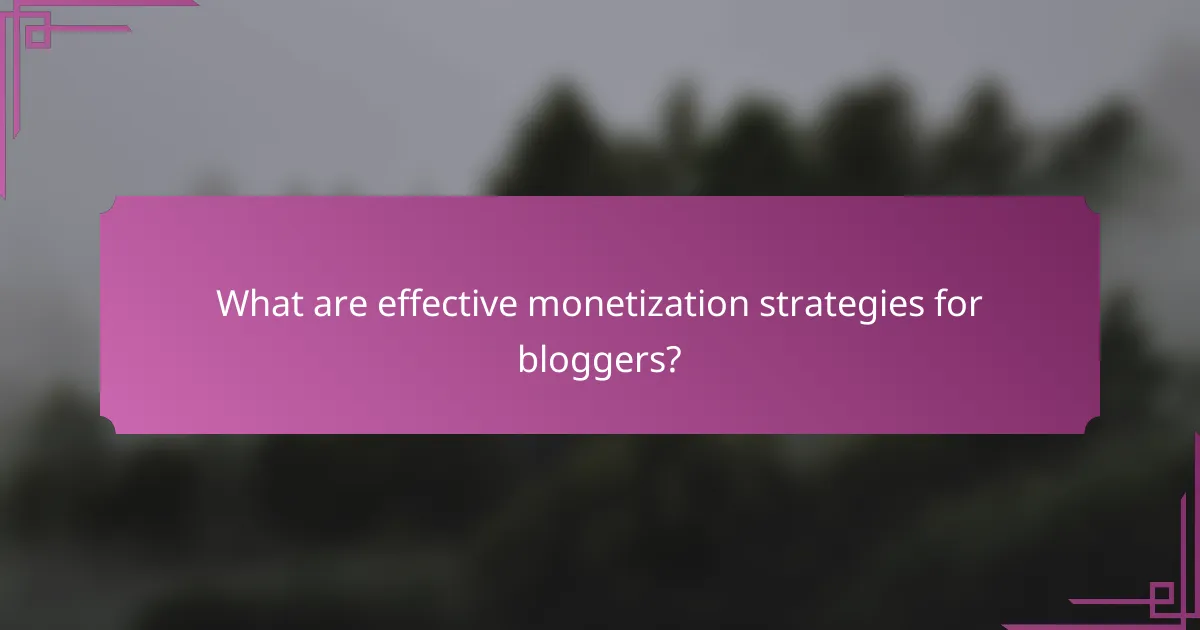
What are effective monetization strategies for bloggers?
Effective monetization strategies for bloggers include display advertising, affiliate marketing, and sponsored content. Each method offers unique benefits and requires different levels of engagement and audience interaction.
Display advertising through Google AdSense
Display advertising, particularly through Google AdSense, allows bloggers to earn money by placing ads on their sites. Bloggers receive revenue based on clicks or impressions, making it a passive income source once set up.
To maximize earnings, focus on optimizing ad placements and ensuring your content attracts a significant amount of traffic. Consider experimenting with different ad formats and sizes to see what performs best with your audience.
Affiliate marketing partnerships
Affiliate marketing involves promoting products or services and earning a commission on sales generated through your referral links. This strategy can be highly lucrative, especially if you align with brands that resonate with your audience.
To succeed, choose affiliate programs that offer competitive commissions and provide quality products. Create authentic content that integrates these products naturally, and avoid overwhelming your readers with too many promotions.
Sponsored content collaborations
Sponsored content collaborations involve partnering with brands to create content that promotes their products or services. This can include blog posts, videos, or social media posts, typically compensated with a flat fee or product exchange.
When engaging in sponsored content, maintain transparency with your audience by disclosing partnerships. Ensure that the sponsored content aligns with your blog’s theme and provides value to your readers to maintain credibility and engagement.
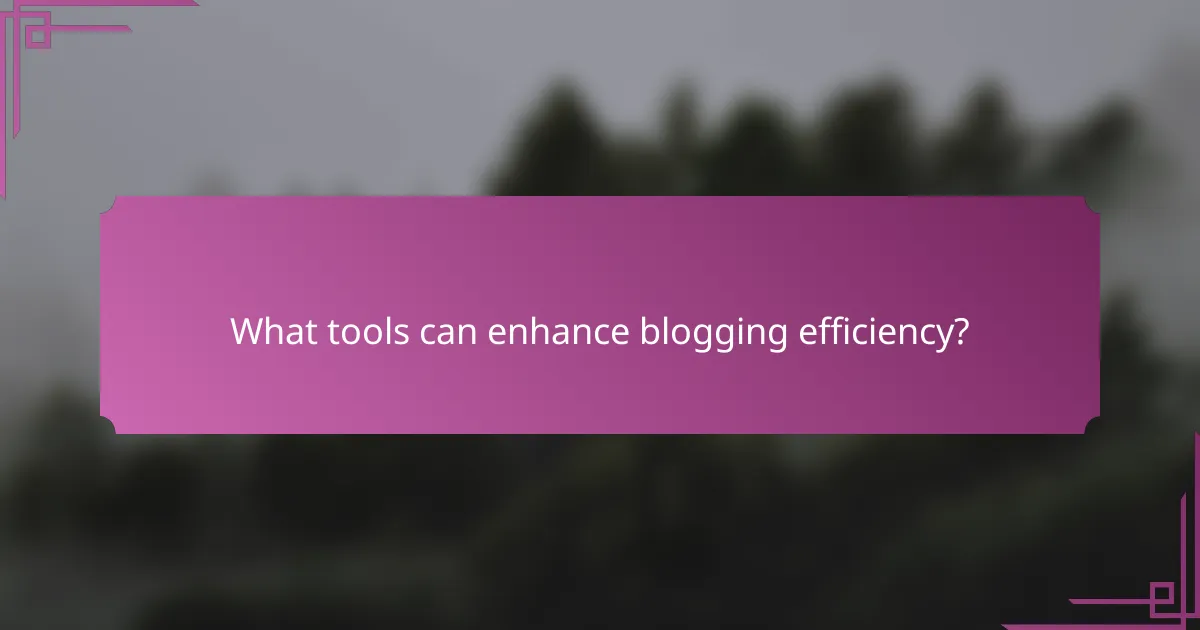
What tools can enhance blogging efficiency?
Several tools can significantly improve blogging efficiency by streamlining content creation, optimizing for search engines, and managing social media presence. Utilizing the right combination of these tools can save time and enhance the overall effectiveness of your blogging strategy.
Content management systems like WordPress
Content management systems (CMS) like WordPress provide a user-friendly platform for creating and managing blog content. They offer customizable templates, plugins for added functionality, and an intuitive interface that simplifies the publishing process.
When choosing a CMS, consider factors such as ease of use, scalability, and support for SEO features. WordPress, for example, has a vast library of plugins that can help optimize your blog for search engines and improve user experience.
SEO tools such as SEMrush
SEO tools like SEMrush are essential for enhancing your blog’s visibility in search engine results. These tools provide insights into keyword performance, backlink analysis, and competitor strategies, allowing you to make informed decisions about your content.
To maximize the benefits of SEO tools, regularly conduct keyword research and track your blog’s performance metrics. This will help you identify areas for improvement and adapt your content strategy accordingly, ensuring you stay relevant in a competitive market.
Social media scheduling platforms like Buffer
Social media scheduling platforms such as Buffer enable bloggers to plan and automate their social media posts, saving time and ensuring consistent engagement with their audience. These tools allow you to schedule posts across multiple platforms, analyze performance, and adjust your strategy based on engagement metrics.
When using a scheduling platform, create a content calendar to organize your posts and maintain a balanced mix of promotional and engaging content. This approach helps in building a loyal audience and driving traffic back to your blog.

What are the key metrics for measuring blogging success?
Key metrics for measuring blogging success include website traffic, engagement rates on social media, and conversion rates for monetization efforts. These metrics provide insight into how well a blog is performing and where improvements can be made.
Website traffic analysis
Website traffic analysis involves tracking the number of visitors to your blog and understanding their behavior. Key tools like Google Analytics can help you monitor metrics such as unique visitors, page views, and bounce rates, which indicate how engaging your content is.
To enhance your traffic, focus on optimizing your content for search engines (SEO) and promoting it through various channels. Aim for a steady increase in traffic over time, ideally reaching thousands of visitors per month, depending on your niche.
Engagement rates on social media
Engagement rates on social media measure how actively your audience interacts with your content. This includes likes, shares, comments, and overall reach on platforms like Facebook, Twitter, and Instagram.
To boost engagement, create shareable content and encourage discussions. A good engagement rate typically falls between 1% to 5%, but this can vary by platform and audience size. Regularly analyze which posts perform best and adjust your strategy accordingly.
Conversion rates for monetization efforts
Conversion rates for monetization efforts track the percentage of visitors who take a desired action, such as signing up for a newsletter or making a purchase. This metric is crucial for assessing the effectiveness of your monetization strategies, including affiliate marketing and sponsored content.
To improve conversion rates, ensure your calls-to-action (CTAs) are clear and compelling. A typical conversion rate for blogs can range from 1% to 5%, but optimizing your landing pages and targeting the right audience can significantly enhance these figures.
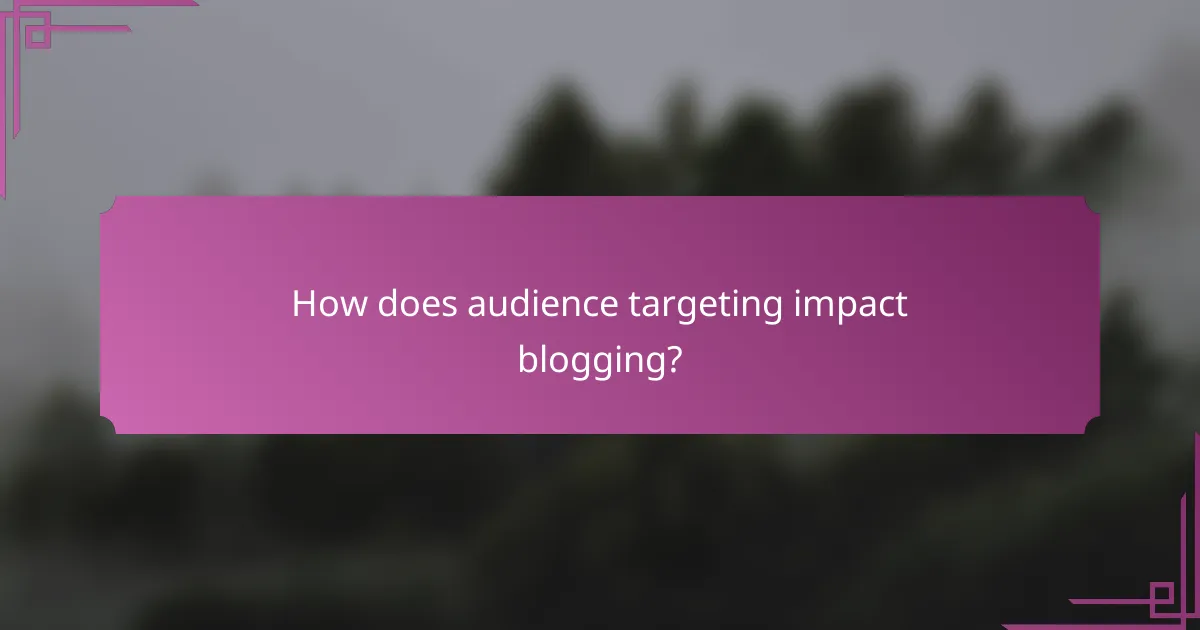
How does audience targeting impact blogging?
Audience targeting significantly enhances blogging effectiveness by ensuring content resonates with specific reader segments. By understanding the preferences and behaviors of your target audience, you can tailor your posts to meet their needs, increasing engagement and loyalty.
Understanding demographic preferences
Demographic preferences refer to the characteristics of your audience, such as age, gender, location, and income level. These factors influence what topics, styles, and formats will resonate most with your readers. For instance, younger audiences may prefer quick, visually engaging content, while older readers might favor in-depth articles.
To effectively target demographics, consider creating reader personas that encapsulate the traits of your ideal audience. This allows you to craft content that speaks directly to their interests and challenges. For example, a blog aimed at millennials might focus on technology trends and lifestyle hacks, while a site for retirees could cover health tips and travel advice.
Utilize analytics tools to gather data on your audience’s demographics. Platforms like Google Analytics can provide insights into who is visiting your blog, helping you adjust your content strategy accordingly. Regularly reviewing this data ensures your blog remains relevant and appealing to your target audience.
